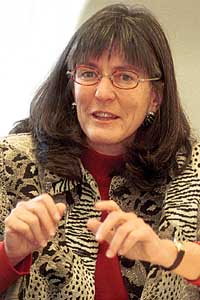Study shows speech and gesture differ in their communication sequences
By William HarmsNews Office
 Susan Goldin-Meadow | |
The ability to develop a form of communication that becomes a simple language is a skill that extends beyond childhood, according to new research on the use of gestures among deaf children and experiments with adults.
Psychologist Susan Goldin-Meadow’s work with adults and children also shows which features of language seem to come more easily and are therefore resilient, such as forming sentences that adhere to a consistent word order.
Her research also shows which characteristics are more difficult to develop, particularly without linguistic input. She has found that youngsters inventing their own sign language do not seem to invent verb tenses, for instance.
Goldin-Meadow, the Irving B. Harris Professor in Psychology and the College, presented her findings in a paper titled “Transforming Gesture into a Simple Language” at the conference of the American Association for the Advancement of Science, held last month.
Her previous work has shown that deaf children of non-deaf adults develop a language-like system of gestures to communicate. To explore further how gestures become a language, Goldin-Meadow and her colleagues tested hearing adults.
They found that adults who were told to use their hands rather than their mouths to communicate created gestures and organized those gestures into the syntax similar to what deaf children use.
For the experiment, the researchers showed the adults a videotape of objects moving in space, for example, a donut-like object moving from an ashtray. The adults were asked to describe the action, first using gestures alone, and later talking about what they observed.
When they used only gestures, the adults formulated their sentences in the same way: making gestures that represented the stationary object (ashtray), moving object (donut) and action (moving). This order is different from the typical order of an English sentence, which has the moving object (donut) making the action (moving) out of the stationary object (ashtray).
In order to determine if that organization reflects something more fundamental about how the mind works, the team then had the adults arrange pictures of the short narrative in two ways: once while talking to a researcher and again while working alone.
People who talked about the movement of the donut-shaped object from the ashtray to the table frequently put the pictures in an order that reflected the spoken English. However, people who organized the pictures without telling someone what they were doing put them in the same order as those who had used gesture only in the earlier experiment: stationary object, moving object and action.
“Finding the same non-English order in a non-communicative context suggests that the order is not driven solely by communication through gesture, but may be a more general property of human thought,” she said.
Goldin-Meadow and her colleagues have explored many ways in which deaf children of non-deaf parents develop a form of sign language before they are taught more conventional systems of sign language.
Although non-deaf parents often gesture when speaking to their deaf children, the children do not duplicate their parents’ gestures, which form an integrated system with the parents’ speech. Instead, the children develop a system of communication in which they can make requests, describe present and non-present situations, and even tell short stories. The gestures are structured with systematic patterns at both word and sentence levels.
“Across the globe, deaf children who are not exposed to a usable conventional language will invent gestures to communicate,” said Goldin-Meadow. “Indeed, all the structures that we have identified in deaf children’s gesture systems can be found in natural language systems that have evolved over generations.”
![[Chronicle]](/images/sidebar_header_oct06.gif)